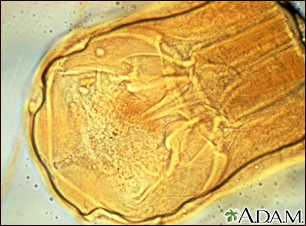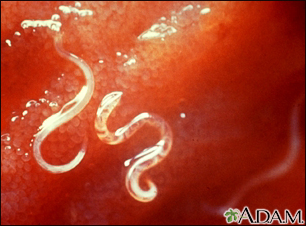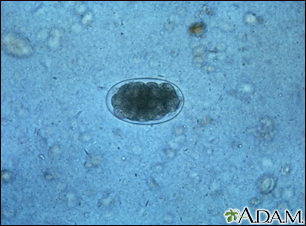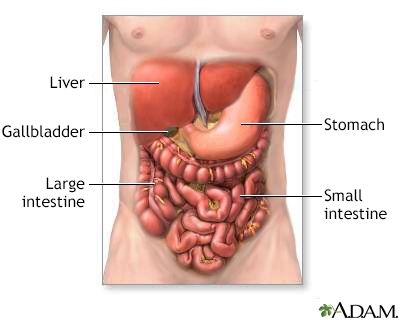Hookworm infection
Hookworm disease; Ground itch; Ancylostoma duodenale infection; Necator americanus infection; Parasitic infection - hookworm
Hookworm infection is caused by roundworms. The disease affects the small intestine and lungs.

This photograph shows the front section of the hookworm, and the mouth parts which it uses to feed. The cutting plates, used to attach to the lining of the intestine where they suck blood for nourishment, are visible. Three species of hookworm cause infection in the United States, including this species, Necator americanus. (Image courtesy of the Centers for Disease Control and Prevention.)

This is the mouth part of the hookworm Ancylostoma duodenale. The hookworm uses sharp, curved cutting plates to attach to the lining of the intestine where it sucks blood for nourishment. (Image courtesy of the Centers for Disease Control and Prevention.)

This is a photograph of a hookworm on the lining of the intestine. (Image courtesy of the Centers for Disease Control and Prevention.)

This is a hookworm egg. Hookworms hatch in damp vegetation. Their larvae can enter the human body through the skin, even without cuts or abrasions. Once through the skin, they begin the next step of their life cycle.

The larva of a hookworm is visible in the center of this photograph.

The digestive system organs in the abdominal cavity include the liver, gallbladder, stomach, small intestine and large intestine.
Causes
The infection is caused by infestation with any of the following roundworms:
- Necator americanus
- Ancylostoma duodenale
- Ancylostoma ceylanicum
- Ancylostoma braziliense
The first two roundworms affect humans only. The last two types also occur in animals.
Hookworm disease is common in the moist tropics and subtropics. In developing nations, the disease leads to the death of many children by weakening their immune system and increasing their risk for infections that their bodies would normally fight off.
There is very little risk of getting the disease in the United States because of advances in sanitation and waste control. The important factor in getting the disease is walking barefoot on ground where there are feces of people who are infected with hookworm.
The larvae (immature form of the worm) enter the skin. The larvae move to the lungs via the bloodstream and enter the airways. The worms are about one-half inch (1 centimeter) long.
After traveling up the windpipe, the larvae are swallowed. After the larvae are swallowed, they infect the small intestine. They develop into adult worms and live there for 1 or more years. The worms attach to the intestinal wall and suck blood, which can result in iron deficiency anemia and protein loss. Adult worms and larvae are released in the feces.
Symptoms
Symptoms may include:
- Abdominal discomfort
- Cough
- Diarrhea
- Fatigue
- Fever
- Gas
- Itchy rash
- Loss of appetite
- Nausea, vomiting
- Pale skin
Most people have no symptoms once the worms enter the intestines.
Exams and Tests
Tests that can help diagnose the infection include:
Treatment
The goals of treatment are to:
- Cure the infection
- Treat complications of anemia
- Improve nutrition
Parasite-killing drugs such as albendazole, mebendazole, or pyrantel pamoate are often prescribed.
Symptoms and complications of anemia are treated, if needed. Your health care provider will likely recommend increasing the amount of protein in your diet.
Outlook (Prognosis)
You will have a complete recovery if you get treated before serious complications develop. Treatment gets rid of the infection.
Possible Complications
Health problems that may result from hookworm infection include:
- Iron deficiency anemia, caused by loss of blood
- Nutritional deficiencies
- Severe protein loss with fluid buildup in the abdomen (ascites)
When to Contact a Medical Professional
Contact your provider for an appointment if symptoms of hookworm infection develop.
Prevention
Handwashing and wearing shoes will reduce the likelihood of infection.
References
Diemert DJ. Nematode infections. In: Goldman L, Cooney KA, eds. Goldman-Cecil Medicine. 27th ed. Philadelphia, PA: Elsevier; 2024:chap 327.
Hotez PJ. Hookworms (Necator americanus and Ancylostoma spp.). In: Kliegman RM, St. Geme JW, Blum NJ, Shah SS, Tasker RC, Wilson KM, eds. Nelson Textbook of Pediatrics. 21st ed. Philadelphia, PA: Elsevier; 2020:chap 318.
Version Info
Last reviewed on: 8/26/2023
Reviewed by: Jatin M. Vyas, MD, PhD, Associate Professor in Medicine, Harvard Medical School; Associate in Medicine, Division of Infectious Disease, Department of Medicine, Massachusetts General Hospital, Boston, MA. Also reviewed by David C. Dugdale, MD, Medical Director, Brenda Conaway, Editorial Director, and the A.D.A.M. Editorial team.
